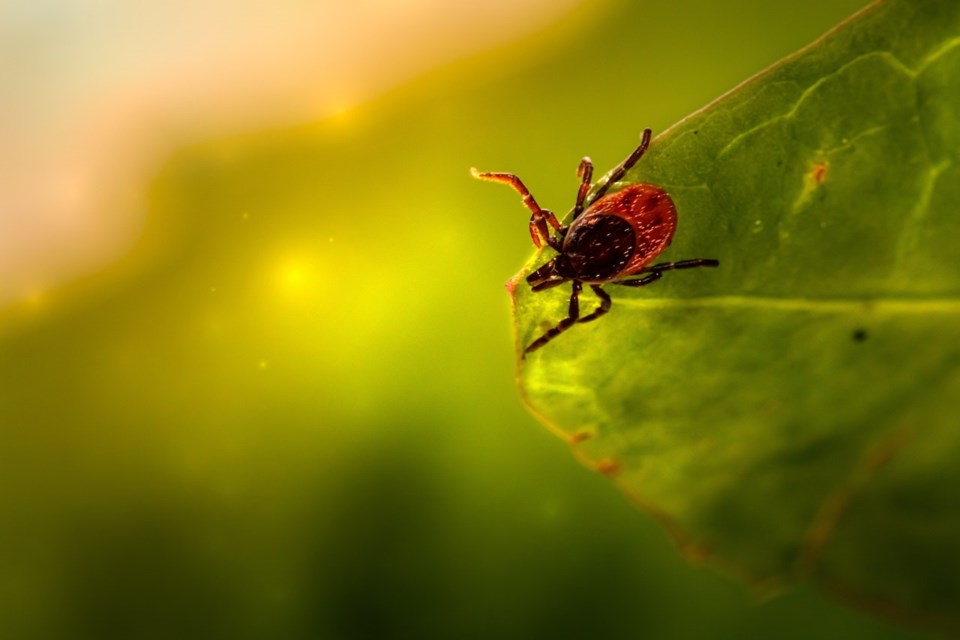A doctor who specializes in illnesses transmitted to humans by insects, such as mosquitoes and ticks, says only one per cent of the ticks in B.C. carry the bacteria that causes Lyme disease.
Dr. Mayank Singal, the medical lead for “enteric, vector-borne and zoonotic diseases” at the BC Centre for Disease Control (BCCDC), adds it’s a very different scenario in eastern regions, such as Ontario, Quebec and Nova Scotia, where the numbers can be as high as between 30 and 40 per cent. That’s not to say, BC doesn’t have its fair share of ticks.
“Ticks are found pretty much across the province. The Sunshine Coast, because of the relatively milder weather, certainly sees its share of ticks,” said Singal. “The season probably starts a little bit earlier, because the milder winters here in B.C. Closer to the coast, we do see tick exposures happening throughout the year, even in the winter sometimes. I've seen people with ticks in January, for example.”
According to the BC Centre for Disease Control (BCCDC), ticks are small bugs that can bite people and pets and can sometimes spread diseases, which can be found in the grass, bushes and forests of B.C. The main tick season on the Coast runs from March through to October.
Singal notes seeing ticks year-round in places like the Sunshine Coast makes sense, because not only are the bugs still around, but people are going to be outside due to the milder weather.
The BCCDC notes, while it is rare, Lyme disease is the most common tick-borne disease in B.C. and North America. It’s transmitted by the bite of Ixodes ticks, which are seen across the province, but most commonly found in southwestern BC, including Vancouver Island, the Gulf Islands, the Sunshine Coast, Greater Vancouver and the Fraser Valley.
Information available on the centre’s website says the geographic distribution of Lyme disease in people and in ticks in B.C. has remained constant over time, from 2013 to 2022, between six to 39 cases of Lyme disease were reported each year, most related to out-of-province travel. Locally acquired cases range from between one and 14 per year. He added there are some other diseases ticks carry, including anaplasmosis and babesiosis, which haven’t been found in humans in B.C., but with climate change and warming temperatures, it’s likely they’ll eventually become more prevalent.
Tick prevention
Singal said when talking about preventing ticks, there are three time periods to consider before heading outdoors. Before heading into the outdoors, it's good to be covered as much as possible. Wear loose, light-coloured clothing that covers your arms and legs and then apply insect repellent that contains bug spray with DEET or icaridin/picaridin on your clothes and uncovered skin.
While you’re in the outdoors, if possible, Singal advises avoiding close contact with foliage, trees and shrubs where ticks are found.
On your return, complete a full-body check on yourself, your partner, kids and pets for ticks, particularly the scalp, armpits and groin areas.
“It's important to really look at those areas to see if there might be ticks hiding in those spots, and then if you do find one, you can either remove it yourself or see your doctor to have it removed,” said Singal.
Removing ticks
Use tweezers to grab the head of the tick and pull it straight out to avoid breaking off any part of its body and then wash the area with soap and then disinfect. Do not touch the tick with bare hands. Take a photo of the tick and submit it to eTick.ca, so it can be identified, then store the insect in a container in the freezer for 30 days. Watch for symptoms such as a rash or fever and talk to a health care provider if you feel unwell within 30 days.
Dogs and ticks
According to the BCCDC, certain animals, including dogs, horses and cows, can also get Lyme disease with symptoms similar to those seen in humans. Dogs are particularly susceptible and symptoms may not appear for one to three weeks or even longer after a tick bite, so watch your canine companions closely for changes in behaviour or appetite.
Tick bites on dogs may be hard to detect but if you do find one, remove it just as you would in a human. Talk to your vet about tick prevention medications for your dog.



